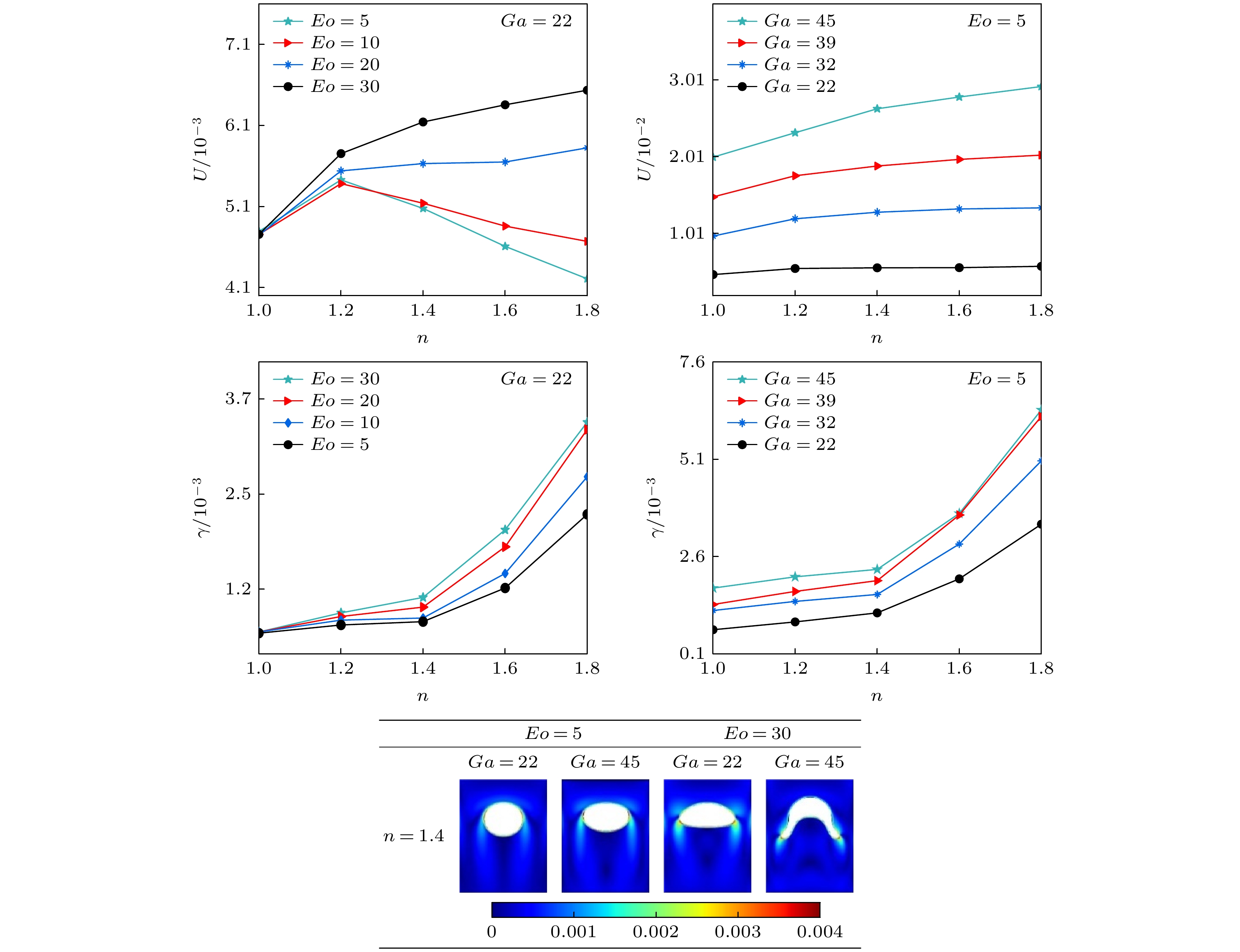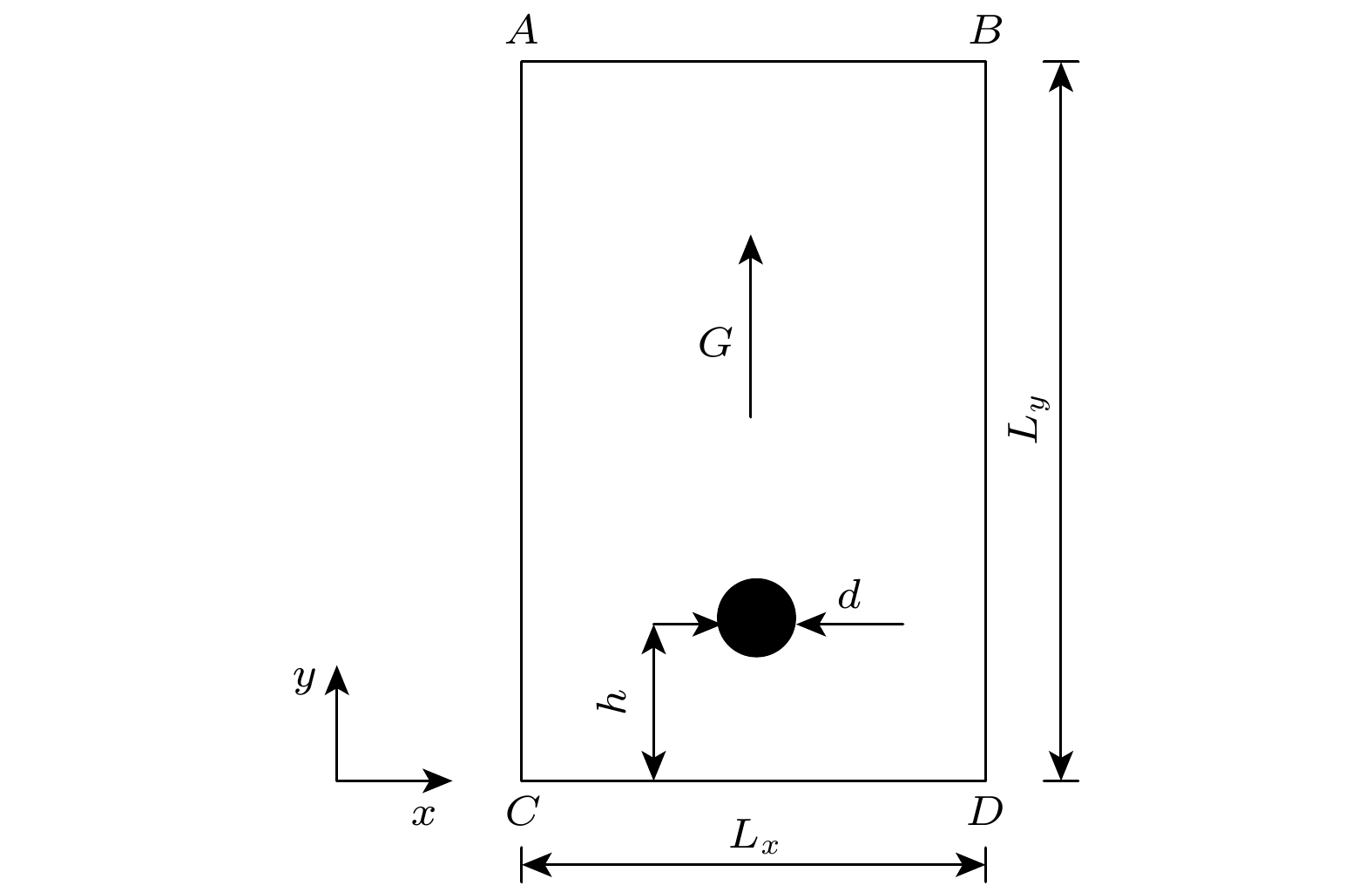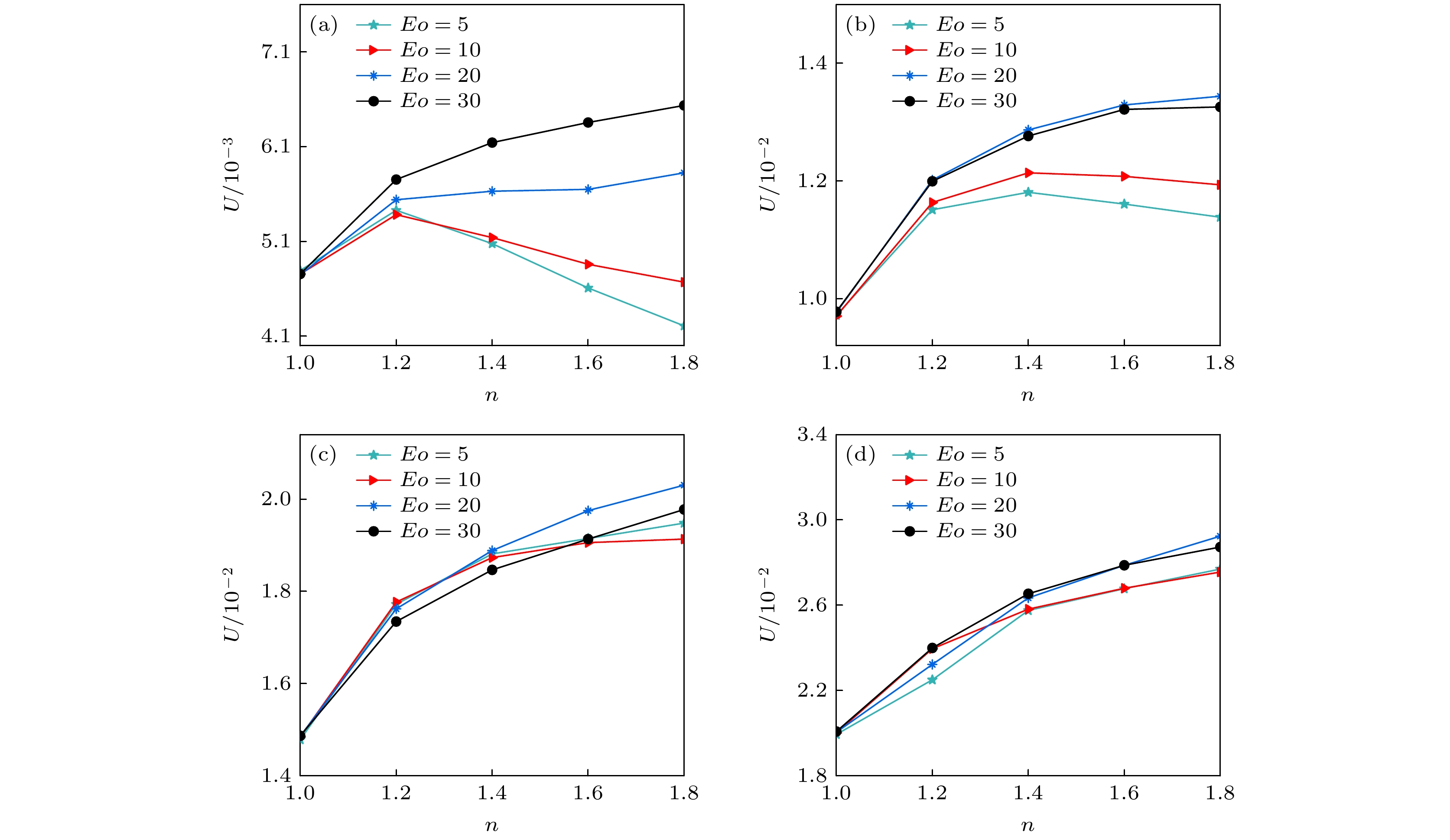-
采用不可压非牛顿气液两相流格子Boltzmann方法研究了剪切增稠流体中气泡上升的动力学行为, 重点分析了流变指数n、Eöυös数(Eo)和Galilei数(Ga)对气泡形变、终端速度和剪切速率的影响. 数值结果表明: 气泡形变程度随Eo的增大而增大, n对气泡形状的影响与Ga相关. 另一方面, 随着Ga增大, 气泡终端速度随n呈非线性单调增大, 且n对终端速度的影响随Ga的增大逐渐明显; 当Ga固定且值较小时, 气泡终端速度在较小Eo下随n的增大先增大后减小, 而当Eo较大时终端速度随n的增大呈增大趋势; 当Ga固定且较大时, 气泡终端速度在Eo较大时较为统一地随n增大而增大. 此外, 气泡左右两端存在剪切速率较高的区域, 该区域尺寸随Eo, Ga的增大而增大, 随n的增大先增大后缩小. 最后利用正交试验法得到上述三变量对剪切速率和终端速度的影响程度. 对于剪切速率, 参数影响程度由大到小的顺序依次为n, Ga和Eo; 对于终端速度, Ga对其影响最大, n次之, Eo影响程度最小.
-
关键词:
- 格子Boltzmann方法 /
- 气泡动力学 /
- 剪切增稠流体
Bubble motion in non-Newtonian fluids is widely present in various industrial processes such as crude oil extraction, enhancement of boiling heat transfer, CO2 sequestration and wastewater treatment. System containing non-Newtonian liquid, as opposed to Newtonian liquid, has shear-dependent viscosity, which can change the hydrodynamic characteristics of the bubbles, such as their size, deformation, instability, terminal velocity, and shear rate, and ultimately affect the bubble rising behaviors. In this work, the dynamic behavior of bubble rising in a shear-thickened fluid is studied by using an incompressible lattice Boltzmann non-Newtonian gas-liquid two-phase flow model. The effects of the rheological exponent n, the Eötvös number (Eo), and the Galilei number (Ga) on the bubble deformation, terminal velocity, and the shear rate are investigated. The numerical results show that the degree of bubble deformation increases as Eo grows, and the effect of n on bubble deformation degree relates to Ga. On the other hand, the terminal velocity of the bubbles increases monotonically and nonlinearly with Ga for given Eo and n, and the effect of n on the terminal velocity of the bubbles turns stronger as Ga increases. When Ga is fixed and small, the terminal velocity of the bubble increases and then decreases with the increase of n at small Eo, and increases with the increase of n when Eo is large; but when Ga is fixed and large, the terminal velocity of the bubbles increases with the increase of n in a more uniform manner. In addition, regions with high shear rates can be found near the left end and right end of the bubble. The size of these regions grows with Eo and Ga, exhibiting an initial increase followed by a decrease as n increases. Finally, the orthogonal experimental method is used to obtain the influences of the aforementioned three factors on the shear rate and terminal velocity. The order of influence on shear rate is n, Ga and Eo which are arranged in descending order. For the terminal velocity, Ga has the greatest influence, followed by n, and Eo has the least influence.-
Keywords:
- lattice Boltzmann method /
- bubble dynamics /
- shear-thickening fluid
[1] Wang C, Lu, Y L, Ye T X, Chen L, He L M 2023 Process Saf. Environ. 180 554
 Google Scholar
Google Scholar
[2] Li E, Zeng X 2021 Water Sci. Technol. 84 404
 Google Scholar
Google Scholar
[3] Xia Y C, Zhang R, Xing Y W, Gui X H 2019 Fuel. 235 687
 Google Scholar
Google Scholar
[4] Hu X D, Wang J F, Xie J, Wang B J, Wang F 2023 Processes 11 2357
 Google Scholar
Google Scholar
[5] Fei L L, Yang J P, Chen Y R, Mo H R, Luo K H 2020 Phys. Rev. Fluids 32 103312
 Google Scholar
Google Scholar
[6] Gollakota A R K, Reddy M, Subramanyam M D, Kishore N 2016 Renew. Sust. Energ. Rev. 58 1543
 Google Scholar
Google Scholar
[7] Chen X L, Wang M Q, Wang B, Hao H D, Shi H L, Wu Z A, Chen J X, Gai L M, Tao H C, Zhu B K, Wang B H 2023 Energies 16 1775
 Google Scholar
Google Scholar
[8] Amirnia S, Debruyn J R, Bergougnou M A, Margaritis A 2013 Chem. Eng. Sci. 94 60
 Google Scholar
Google Scholar
[9] Li S B, Ma Y G, Jiang S K, Fu T T, Zhu C Y, Li H Z 2012 J. Fluid. Eng. 134 084501
 Google Scholar
Google Scholar
[10] Zhang L, Yang C, Mao Z S 2010 J. Non-Newtonian Fluid Mech. 165 555
 Google Scholar
Google Scholar
[11] Premlata A R, Tripathi M K, Karri B, Sahu K C 2017 J. Non-Newtonian Fluid Mech. 239 53
 Google Scholar
Google Scholar
[12] Pang M J, Lu M J 2018 Vacuum 153 101
 Google Scholar
Google Scholar
[13] Pan K L, Chen Z J 2014 J. Comput. Appl. Math. 67 290
 Google Scholar
Google Scholar
[14] Tripathi M K, Sahu K C, Karapetsas G, Matar O K 2015 J. Non-Newtonian Fluid Mech. 222 217
 Google Scholar
Google Scholar
[15] Pillapakkam S B, Singh P, Blackmore D, Aubry N 2007 J. Fluid Mech. 589 215
 Google Scholar
Google Scholar
[16] Xu X F, Zhang J, Liu F X, Wang X J, Wei W, Liu Z J 2017 Int. J. Multiph. Flow 95 84
 Google Scholar
Google Scholar
[17] Battistella A, van Schijndel S J G, Roghair I 2020 J. Non-Newtonian Fluid Mech. 278 104249
 Google Scholar
Google Scholar
[18] Morris J F 2020 Annu. Rev. Fluid Mech 52 121
 Google Scholar
Google Scholar
[19] Wei M H, Lin K, Sun L 2022 Mater. Des. 216 110570
 Google Scholar
Google Scholar
[20] Ohta M, Kimura S, Furukawa T, Yoshida Y, Sussman M 2012 J. Chem. Eng. Jpn. 45 713
 Google Scholar
Google Scholar
[21] Ezzatneshan E, Khosroabadi A A 2022 J. Appl. Fluid Mech. 15 1771
 Google Scholar
Google Scholar
[22] Zhang R Y, He X Y, Chen S Y 2000 Comput. Phys. Commun. 129 121
 Google Scholar
Google Scholar
[23] He X Y, Chen S Y, Zhang R Y 1999 J. Comput. Phys. 152 642
 Google Scholar
Google Scholar
[24] Du Rui, Wang Y B 2021 Appl. Math. Lett. 114 106911
 Google Scholar
Google Scholar
[25] Chai Z H, Shi B C, Zhan C J 2022 Phys. Rev. E 106 055305
 Google Scholar
Google Scholar
[26] Wanga L, Hea K, Wang H L 2023 Phys. Rev. E 108 055306
 Google Scholar
Google Scholar
[27] Yu Y, Li Q, Qiu Y, Huang R Z 2021 Phys. Fluids 33 083306
 Google Scholar
Google Scholar
[28] Liang H, Li Y, Chen J X, Xu J R 2019 Int. J. Heat Mass Tran. 130 1189
 Google Scholar
Google Scholar
[29] Luo J W, Chen L, Ke H B, Zhang C D, Xia Y, Tao W Q 2023 Appl. Therm. Eng. 236 121732
 Google Scholar
Google Scholar
[30] 娄钦, 黄一帆, 李凌 2019 物理学报 68 214702
 Google Scholar
Google Scholar
Lou Q, Huang Y F, Li L 2019 Acta Phys. Sin. 68 214702
 Google Scholar
Google Scholar
[31] Peng Y, Laura S 2006 Phys. Fluids 18 042101
 Google Scholar
Google Scholar
[32] Chai Z H, Zhao T S 2012 Phys. Rev. E 86 016705
 Google Scholar
Google Scholar
-
表 1 不同参数下得到的气泡终端形状 (a) Eo = 200; (b) Ga = 3.0
Table 1. Bubble terminal deformation at different values of Eo and Ga: (a) Eo = 200; (b) Ga = 3.0.
表 2 气泡形状图
Table 2. Bubble shape map.
Ga = 22 Ga = 32 n = 1.0 n = 1.2 n = 1.4 n = 1.6 n = 1.8 n = 1.0 n = 1.2 n = 1.4 n = 1.6 n = 1.8 Eo = 5 
Eo = 10 
Eo = 20 
Eo = 30 
Ga = 39 Ga = 45 n = 1.0 n = 1.2 n = 1.4 n = 1.6 n = 1.8 n = 1.0 n = 1.2 n = 1.4 n = 1.6 n = 1.8 Eo = 5 
Eo = 10 
Eo = 20 
Eo = 30 
表 3 气泡周围剪切速率分布
Table 3. Shear rate distribution around the bubble.
Eo = 5 Eo = 30 Ga = 22 Ga = 45 Ga = 22 Ga = 45 n = 1 



n = 1.2 



n = 1.4 



n = 1.6 



n = 1.8 




表 4 因素水平表
Table 4. Table of factor levels.
水平 因素 n Ga Eo ① 1.0 22 5 ② 1.2 32 10 ③ 1.4 39 20 ④ 1.6 45 30 ⑤ 1.8 — — 表 5 针对剪切速率的试验正交表
Table 5. Orthogonal table of tests for shear rate.
试验次数 因 素 剪切速率
(×10–6)n Ga Eo 1 1.0 22 5 718 2 1.0 32 20 1152 3 1.0 39 30 1443 4 1.0 45 10 1743 5 1.0 45 30 1673 6 1.2 22 30 798 7 1.2 32 10 1325 8 1.2 39 30 1659 9 1.2 45 5 2078 10 1.2 45 20 2035 11 1.4 22 30 837 12 1.4 32 5 1625 13 1.4 39 20 1904 14 1.4 45 30 2033 15 1.4 45 10 1872 16 1.6 22 20 1464 17 1.6 32 30 1747 18 1.6 39 10 2532 19 1.6 45 30 2732 20 1.6 45 5 3707 21 1.8 22 10 3329 22 1.8 32 30 2903 23 1.8 39 5 6200 24 1.8 45 20 4016 25 1.8 45 30 3519 表 8 针对终端速度的数据分析
Table 8. Data analysis for terminal speed.
试验均值/极差 因 素 n Ga Eo k1 1390.0 540.0 1707.0 k2 1608.8 1193.6 1623.6 k3 1783.8 1792.8 1735.2 k4 1851.4 2507.6 1737.9 k5 1907.6 — — R 517.6 1967.6 114.3 表 7 针对终端速度的试验正交表
Table 7. Orthogonal table of tests for terminal speed.
试验次数 因 素 终端速度
(×10–6)n Ga Eo 1 1.0 22 5 479 2 1.0 32 20 976 3 1.0 39 30 1487 4 1.0 45 10 2001 5 1.0 45 30 2007 6 1.2 22 30 575 7 1.2 32 10 1163 8 1.2 39 30 1734 9 1.2 45 5 2250 10 1.2 45 20 2322 11 1.4 22 30 614 12 1.4 32 5 1181 13 1.4 39 20 1889 14 1.4 45 30 2654 15 1.4 45 10 2581 16 1.6 22 20 565 17 1.6 32 30 1322 18 1.6 39 10 1906 19 1.6 45 30 2787 20 1.6 45 5 2677 21 1.8 22 10 467 22 1.8 32 30 1326 23 1.8 39 5 1948 24 1.8 45 20 2924 25 1.8 45 30 2873 表 6 针对剪切速率的数据分析
Table 6. Data analysis for shear rate.
试验均值/极差 因 素 n Ga Eo k1 1345.8 1429.2 2865.6 k2 1579.0 1750.4 2160.2 k3 1654.2 2747.6 2114.2 k4 2436.4 2540.8 1934.4 k5 3993.4 — — R 2647.6 1318.4 931.2 -
[1] Wang C, Lu, Y L, Ye T X, Chen L, He L M 2023 Process Saf. Environ. 180 554
 Google Scholar
Google Scholar
[2] Li E, Zeng X 2021 Water Sci. Technol. 84 404
 Google Scholar
Google Scholar
[3] Xia Y C, Zhang R, Xing Y W, Gui X H 2019 Fuel. 235 687
 Google Scholar
Google Scholar
[4] Hu X D, Wang J F, Xie J, Wang B J, Wang F 2023 Processes 11 2357
 Google Scholar
Google Scholar
[5] Fei L L, Yang J P, Chen Y R, Mo H R, Luo K H 2020 Phys. Rev. Fluids 32 103312
 Google Scholar
Google Scholar
[6] Gollakota A R K, Reddy M, Subramanyam M D, Kishore N 2016 Renew. Sust. Energ. Rev. 58 1543
 Google Scholar
Google Scholar
[7] Chen X L, Wang M Q, Wang B, Hao H D, Shi H L, Wu Z A, Chen J X, Gai L M, Tao H C, Zhu B K, Wang B H 2023 Energies 16 1775
 Google Scholar
Google Scholar
[8] Amirnia S, Debruyn J R, Bergougnou M A, Margaritis A 2013 Chem. Eng. Sci. 94 60
 Google Scholar
Google Scholar
[9] Li S B, Ma Y G, Jiang S K, Fu T T, Zhu C Y, Li H Z 2012 J. Fluid. Eng. 134 084501
 Google Scholar
Google Scholar
[10] Zhang L, Yang C, Mao Z S 2010 J. Non-Newtonian Fluid Mech. 165 555
 Google Scholar
Google Scholar
[11] Premlata A R, Tripathi M K, Karri B, Sahu K C 2017 J. Non-Newtonian Fluid Mech. 239 53
 Google Scholar
Google Scholar
[12] Pang M J, Lu M J 2018 Vacuum 153 101
 Google Scholar
Google Scholar
[13] Pan K L, Chen Z J 2014 J. Comput. Appl. Math. 67 290
 Google Scholar
Google Scholar
[14] Tripathi M K, Sahu K C, Karapetsas G, Matar O K 2015 J. Non-Newtonian Fluid Mech. 222 217
 Google Scholar
Google Scholar
[15] Pillapakkam S B, Singh P, Blackmore D, Aubry N 2007 J. Fluid Mech. 589 215
 Google Scholar
Google Scholar
[16] Xu X F, Zhang J, Liu F X, Wang X J, Wei W, Liu Z J 2017 Int. J. Multiph. Flow 95 84
 Google Scholar
Google Scholar
[17] Battistella A, van Schijndel S J G, Roghair I 2020 J. Non-Newtonian Fluid Mech. 278 104249
 Google Scholar
Google Scholar
[18] Morris J F 2020 Annu. Rev. Fluid Mech 52 121
 Google Scholar
Google Scholar
[19] Wei M H, Lin K, Sun L 2022 Mater. Des. 216 110570
 Google Scholar
Google Scholar
[20] Ohta M, Kimura S, Furukawa T, Yoshida Y, Sussman M 2012 J. Chem. Eng. Jpn. 45 713
 Google Scholar
Google Scholar
[21] Ezzatneshan E, Khosroabadi A A 2022 J. Appl. Fluid Mech. 15 1771
 Google Scholar
Google Scholar
[22] Zhang R Y, He X Y, Chen S Y 2000 Comput. Phys. Commun. 129 121
 Google Scholar
Google Scholar
[23] He X Y, Chen S Y, Zhang R Y 1999 J. Comput. Phys. 152 642
 Google Scholar
Google Scholar
[24] Du Rui, Wang Y B 2021 Appl. Math. Lett. 114 106911
 Google Scholar
Google Scholar
[25] Chai Z H, Shi B C, Zhan C J 2022 Phys. Rev. E 106 055305
 Google Scholar
Google Scholar
[26] Wanga L, Hea K, Wang H L 2023 Phys. Rev. E 108 055306
 Google Scholar
Google Scholar
[27] Yu Y, Li Q, Qiu Y, Huang R Z 2021 Phys. Fluids 33 083306
 Google Scholar
Google Scholar
[28] Liang H, Li Y, Chen J X, Xu J R 2019 Int. J. Heat Mass Tran. 130 1189
 Google Scholar
Google Scholar
[29] Luo J W, Chen L, Ke H B, Zhang C D, Xia Y, Tao W Q 2023 Appl. Therm. Eng. 236 121732
 Google Scholar
Google Scholar
[30] 娄钦, 黄一帆, 李凌 2019 物理学报 68 214702
 Google Scholar
Google Scholar
Lou Q, Huang Y F, Li L 2019 Acta Phys. Sin. 68 214702
 Google Scholar
Google Scholar
[31] Peng Y, Laura S 2006 Phys. Fluids 18 042101
 Google Scholar
Google Scholar
[32] Chai Z H, Zhao T S 2012 Phys. Rev. E 86 016705
 Google Scholar
Google Scholar
计量
- 文章访问数: 4566
- PDF下载量: 154
- 被引次数: 0















 下载:
下载:















